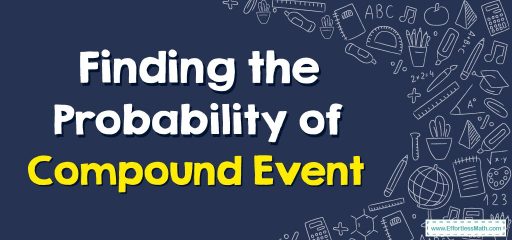How to Find the Probability of Compound Event?
Compound probability is the probability of two or more independent events occurring together. In this article, you will learn how to find the probability of a compound event in a few simple steps.

Related Topics
A step-by-step guide to finding the probability of a compound event
The compound probability of compound events (mutually inclusive or mutually exclusive) can be defined as the probability of two or more independent events occurring together. An independent event is an event whose outcome is not affected by the outcomes of other events.
A mutually inclusive event involves a situation where one event cannot occur with the other while an exclusive mutual event is when both events cannot occur at the same time. The compound probability will always lie between \(0\) and \(1\).
Compound probability formulas
There are two formulas for calculating compound probability depending on the type of events that occur.In general, to find the compound probability, the probability of the first event is multiplied by the probability of the second event, and so on. The compound probability formulas are given below:
Mutually exclusive events compound the probability
\(\color{blue}{P(A\: or B) = P(A) + P(B)}\)
Using set theory, this formula is presented as follows:
\(\color{blue}{P\left(A\:∪\:B\right)\:=\:P\left(A\right)\:+\:P\left(B\right)}\)
Mutually inclusive events compound the probability
\(\color{blue}{P\left(A\:or\:B\right)\:=\:P\left(A\right)\:+\:P\left(B\right)\:-\:P\left(A\:and\:B\right)}\)
\(\color{blue}{P\left(A\:∪\:B\right)\:=\:P\left(A\right)\:+\:P\left(B\right)\:-\:P\left(A\:⋂\:B\right)}\)
where \(A\) and \(B\) are two independent events, and \(\color{blue}{P\left(A\:and\:B\right)\:=\:P\left(A\right)\times \:P\left(B\right)}\)
Finding the Probability of Compound Event – Example 1:
If a dice is rolled, find the compound probability that either a \(2\) or \(4\) will be obtained.
Solution: \(P (2)=\frac {1}{6}\), \(P(4)= \frac{1}{6}\)
Since this is an example of a mutually exclusive event, therefore, the compound probability formula is used: \(P\left(A\:or\:B\right)\:=\:P\left(A\right)\:+\:P\left(B\right)\)
\(P (2\: or\: 3)=\frac {1}{6}+\frac {1}{6}\)
\(=\frac {1}{3}\)
Related to This Article
More math articles
- 5 Awesome Tips to Boost Your Child’s Math Skills Easily!
- 4th Grade PSSA Math Worksheets: FREE & Printable
- Calculus Simplified: Essential Integral Formulas for Mathematical Success
- Why So Many Students Struggle with Math Anxiety and How to Deal with It
- How to Master the Concept of Continuity over an Interval
- 15 Geniuses who changed the world of mathematics forever
- How to Solve the Converse of Pythagoras’ Theorem Problems?
- Exploring the World of Geometry: The Intricacies of Similarity
- Differential Equations: Laws of The Universe Unraveled
- Things to Think About When Picking a College for Math Majors


























What people say about "How to Find the Probability of Compound Event? - Effortless Math: We Help Students Learn to LOVE Mathematics"?
No one replied yet.